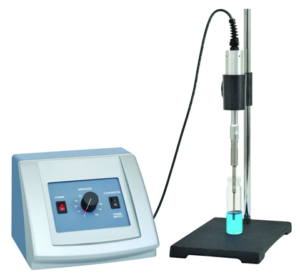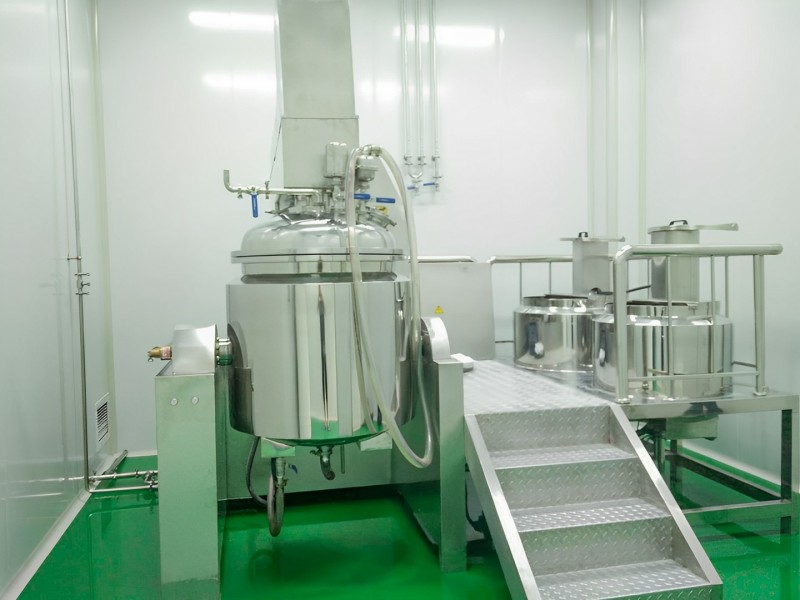-
What is ultrasonic homogenizer?
(1) Ultrasonic homogenizer is a device that utilizes ultrasonic technology for homogenization.
(2) It usually consists of an ultrasonic generator, a mass transfer head, a control system, and a measurement system.
(3) The ultrasonic generator generates high-frequency sound waves and guides the mixture into a mass transfer head, which can filter, mix, and disperse ultrasonic energy, thereby dispersing the molecules in the mixture to various areas.
(4) Under the action of ultrasound, the particle size of liquid-liquid and solid-liquid materials narrows, allowing one phase to be uniformly distributed into another or multiple phases, achieving a refined and homogeneous dispersion emulsification effect, thereby forming a stable emulsion state.
(5) The working principle of an ultrasonic homogenizer is to achieve homogenization by utilizing the cavitation and other physical effects of ultrasonic waves in liquids.
(6) Among them, cavitation refers to the formation of holes or small bubbles in weaker areas of the liquid under the action of ultrasound. The small bubbles will collapse with the fluctuation of ultrasound within one sound cycle.
(7) Ultrasonic cavitation can also generate strong mechanical effects, producing fast jets or acoustic impulses near solid interfaces and strong shock waves in liquids.
(8) Physical effects refer to the effective agitation and flow of ultrasonic waves in liquids, which can damage the structure of the medium and crush particles in the liquid. These are mainly caused by collisions between liquids, microphase flow, and shock waves, leading to changes in the surface morphology of particles.
-
What are the applications of ultrasonic homogenizer?
The application of ultrasonic homogenizers is very extensive, including but not limited to the following aspects:
(1) Cell and microbial fragmentation: In the laboratory, ultrasonic homogenizers are often used to break down cell walls to extract cell contents without damaging them. The purpose of cell breakdown or lysis is to destroy a part or the entire cell wall to release biomolecules such as plasmids, receptor assays, proteins, DNA, RNA, etc. These substances can be further isolated, organelle separated, and protein extracted and purified for use in proteomics research, for example.
(2) Food and cosmetics industry: Ultrasonic homogenizers can be used for sample preparation in the food and cosmetics industry, such as catalysts, matting agents, pigments, graphite, paint coatings, alumina, composite fertilizers, fillers, herbicides, fungicides, powder emulsions, nanomaterial preparation, etc.
(3) Environmental monitoring and sample preparation: In environmental laboratories, ultrasonic homogenizers can be used to continuously check for the presence of heavy metals, fats, or oils in industrial wastewater, in order to take immediate action when the concentration exceeds the standard. In order to obtain representative analysis results, it is necessary to transform the wastewater sample into a homogeneous state.
(4) Agricultural and Botany Research: In agriculture, ultrasonic homogenizers can be used for sample preparation, such as dense and fine homogenization of rose cells to obtain particle sizes less than 1 μ Samples of m.
(5) Industrial applications: In the industrial field, ultrasonic homogenizers not only have laboratory functions, but also have applications such as cleaning, welding, fabric and food cutting. In addition, it should also be used in industries such as pharmaceuticals, environmental protection, and petrochemicals.
(6) Sonochemistry and sonocatalysis: Ultrasonic homogenizers can be used in sonochemical and sonocatalytic reactions, providing more effective energy use, increasing the reactivity of reagents or catalysts, and providing sonochemical conversion methods and reaction pathways.
(7) In addition, companies such as Hielscher also offer a variety of products for laboratory and desktop ultrasonic processors, as well as industrial applications. Important applications include homogenization, emulsification, dispersion, degreasing and agglomeration, as well as sonochemistry and sonocatalysis.
-
The ultrasonic homogenizer has the following advantages:
(1) Efficient: capable of efficiently crushing samples in a short period of time, improving crushing efficiency.
(2) Easy to operate: The equipment operation process is simple and only requires a few minutes of training to get started.
(3) Low experimental cost: No need to add expensive chemical reagents or a large amount of sample pretreatment, thereby reducing experimental costs.
(4) Precision control: The power of the ultrasonic generator is adjustable, with wide applicability, and can be precisely controlled according to different needs.
(5) Improving experimental efficiency: Samples that have been homogenized can greatly improve the efficiency of subsequent experiments, saving time and cost.
(6) High repeatability: This device has high repeatability, which can greatly reduce experimental errors and improve the credibility and accuracy of experimental data.
(7) Flexible power supply selection: The input power supply is flexible, including AC 220V, 380V, and DC input.
-
Ultrasonic homogenizers have some disadvantages, mainly including the following points:
(1) Limited to small sample processing: Ultrasonic homogenizers are suitable for small sample processing. When the sample volume is too large, it is easily hindered by ultrasound, resulting in unsatisfactory results.
(2) High energy consumption: Ultrasonic homogenizers require significant energy consumption and generate significant heat during use, requiring heat dissipation treatment of the equipment.
(3) Easy to be affected by operating environment: Ultrasonic homogenizers are susceptible to external factors such as temperature, humidity, etc., which can also affect their crushing effect.
(4) High equipment cost: The cost of ultrasonic homogenizers is relatively high, which may be difficult for some laboratories with limited budgets to afford.
(5) Professional operation and maintenance are required: The ultrasonic homogenizer requires professional personnel to operate and maintain it to ensure its normal operation and effectiveness.
-
What is the difference between ultrasonic homogenizer and homogenizer?
The main difference between ultrasonic homogenizers and ordinary homogenizers lies in their working principles and application areas.
(1) Working principle: The ultrasonic homogenizer utilizes high-frequency sound waves to generate cavitation, decomposing particles and droplets in the mixture, thereby achieving homogenization. Ordinary homogenizers, on the other hand, usually use mechanical stirring or high-pressure emulsification to break and mix the particles and droplets in the sample evenly.
(2) Application field: Ultrasonic homogenizers are mainly used in fields such as biology, chemistry, and medicine, especially in experiments that require cell fragmentation or extraction of intracellular substances. Ordinary homogenizer is widely used in food, cosmetics, pharmaceutical and other industries to prepare lotion, suspension and other products.
(3) Processing effect: The ultrasonic homogenizer has the characteristics of high efficiency, speed, and uniformity, which can achieve efficient processing of small samples, and the processed samples have good stability. Ordinary homogenizers can choose different mixing or emulsification methods according to different processing requirements to meet different uniformity and stability requirements.
(4) Operation and maintenance: The ultrasonic homogenizer requires professional personnel to operate and maintain, as its working principle involves the generation and propagation of high-frequency sound waves. Ordinary homogenizers are relatively easy to operate and maintain, and ordinary personnel can become proficient through training.









I do trust all the ideas youve presented in your post They are really convincing and will definitely work Nonetheless the posts are too short for newbies May just you please lengthen them a bit from next time Thank you for the post
Thanks I have recently been looking for info about this subject for a while and yours is the greatest I have discovered so far However what in regards to the bottom line Are you certain in regards to the supply
My brother suggested I might like this website He was totally right This post actually made my day You cannt imagine just how much time I had spent for this information Thanks
Hello my loved one I want to say that this post is amazing great written and include almost all significant infos I would like to look extra posts like this
Which hosting service are you using? Could I have your host’s affiliate link? My website loads far slower than yours does. Excellent blog as well.
You make complex topics easy to understand.